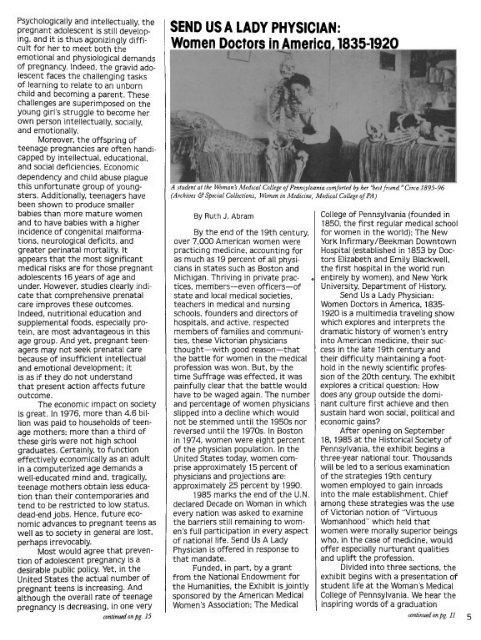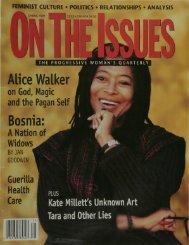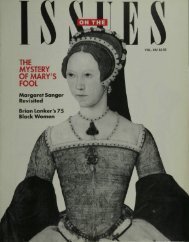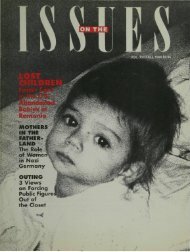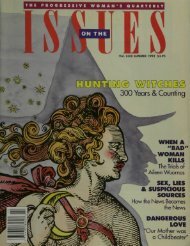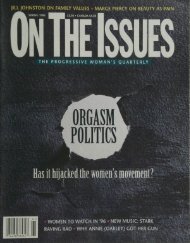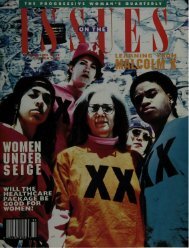view entire issue in pdf format - On The Issues Magazine
view entire issue in pdf format - On The Issues Magazine
view entire issue in pdf format - On The Issues Magazine
You also want an ePaper? Increase the reach of your titles
YUMPU automatically turns print PDFs into web optimized ePapers that Google loves.
Psychologically and <strong>in</strong>tellectually, thepregnant adolescent is still develop<strong>in</strong>g,and it is thus agoniz<strong>in</strong>gly difficultfor her to meet both theemotional and physiological demandsof pregnancy. Indeed, the gravid adolescentfaces the challeng<strong>in</strong>g tasksof learn<strong>in</strong>g to relate to an unbornchild and becom<strong>in</strong>g a parent. <strong>The</strong>sechallenges are superimposed on theyoung girl's struggle to become herown person <strong>in</strong>tellectually, socially,and emotionally.Moreover, the offspr<strong>in</strong>g ofteenage pregnancies are often handicappedby <strong>in</strong>tellectual, educational,and social deficiencies. Economicdependency and child abuse plaguethis unfortunate group of youngsters.Additionally, teenagers havebeen shown to produce smallerbabies than more mature womenand to have babies with a higher<strong>in</strong>cidence of congenital mal<strong>format</strong>ions,neurological deficits, andgreater per<strong>in</strong>atal mortality. Itappears that the most significantmedical risks are for those pregnantadolescents 16 years of age andunder. However, studies clearly <strong>in</strong>dicatethat comprehensive prenatalcare improves these outcomes.Indeed, nutritional education andsupplemental foods, especially prote<strong>in</strong>,are most advantageous <strong>in</strong> thisage group. And yet, pregnant teenagersmay not seek prenatal carebecause of <strong>in</strong>sufficient <strong>in</strong>tellectualand emotional development; itis as if they do not understandthat present action affects futureoutcome.<strong>The</strong> economic impact on societyis great. In 1976, more than 4.6 billionwas paid to households of teenagemothers; more than a third ofthese girls were not high schoolgraduates. Certa<strong>in</strong>ly, to functioneffectively economically as an adult<strong>in</strong> a computerized age demands awell-educated m<strong>in</strong>d and, tragically,teenage mothers obta<strong>in</strong> less educationthan their contemporaries andtend to be restricted to low status,dead-end jobs. Hence, future economicadvances to pregnant teens aswell as to society <strong>in</strong> general are lost,perhaps irrevocably.Most would agree that preventionof adolescent pregnancy is adesirable public policy. Yet, <strong>in</strong> theUnited States the actual number ofpregnant teens is <strong>in</strong>creas<strong>in</strong>g. Andalthough the overall rate of teenagepregnancy is decreas<strong>in</strong>g, <strong>in</strong> one verycont<strong>in</strong>ued on pg. 15SEND USA LADY PHYSICIAN:Women Doctors <strong>in</strong> America,A student at the Woman's Medical College of Pennsylvania comforted by her "best friend." Circa 1895-96(Archives & Special Collections, Women <strong>in</strong> Medic<strong>in</strong>e, Medical College of PA)By Ruth J. AbramBy the end of the 19th century,over 7,000 American women werepractic<strong>in</strong>g medic<strong>in</strong>e, account<strong>in</strong>g foras much as 19 percent of all physicians<strong>in</strong> states such as Boston andMichigan. Thriv<strong>in</strong>g <strong>in</strong> private practices,members—even officers—ofstate and local medical societies,teachers <strong>in</strong> medical and nurs<strong>in</strong>gschools, founders and directors ofhospitals, and active, respectedmembers of families and communities,these Victorian physiciansthought—with good reason—thatthe battle for women <strong>in</strong> the medicalprofession was won. But, by thetime Suffrage was effected, it waspa<strong>in</strong>fully clear that the battle wouldhave to be waged aga<strong>in</strong>. <strong>The</strong> numberand percentage of women physiciansslipped <strong>in</strong>to a decl<strong>in</strong>e which wouldnot be stemmed until the 1950s norreversed until the 1970s. In Boston<strong>in</strong> 1974, women were eight percentof the physician population. In theUnited States today, women compriseapproximately 15 percent ofphysicians and projections are:approximately 25 percent by 1990.1985 marks the end of the U.N.declared Decade on Woman <strong>in</strong> whichevery nation was asked to exam<strong>in</strong>ethe barriers still rema<strong>in</strong><strong>in</strong>g to women'sfull participation <strong>in</strong> every aspectof national life. Send Us A LadyPhysician is offered <strong>in</strong> response tothat mandate.Funded, <strong>in</strong> part, by a grantfrom the National Endowment forthe Humanities, the Exhibit is jo<strong>in</strong>tlysponsored by the American MedicalWomen's Association; <strong>The</strong> MedicalCollege of Pennsylvania (founded <strong>in</strong>1850, the first regular medical schoolfor women <strong>in</strong> the world); <strong>The</strong> NewYork Infirmary/Beekman DowntownHospital (established <strong>in</strong> 1853 by DoctorsElizabeth and Emily Blackwell,the first hospital <strong>in</strong> the world run<strong>entire</strong>ly by women), and New YorkUniversity, Department of History.Send Us a Lady Physician:Women Doctors <strong>in</strong> America, 1835-1920 is a multimedia travel<strong>in</strong>g showwhich explores and <strong>in</strong>terprets thedramatic history of women's entry<strong>in</strong>to American medic<strong>in</strong>e, their success<strong>in</strong> the late 19th century andtheir difficulty ma<strong>in</strong>ta<strong>in</strong><strong>in</strong>g a foothold<strong>in</strong> the newly scientific professionof the 20th century. <strong>The</strong> exhibitexplores a critical question: Howdoes any group outsjde the dom<strong>in</strong>antculture first achieve and thensusta<strong>in</strong> hard won social, political andeconomic ga<strong>in</strong>s?After open<strong>in</strong>g on September18, 1985 at the Historical Society ofPennsylvania, the exhibit beg<strong>in</strong>s athree-year national tour. Thousandswill be led to a serious exam<strong>in</strong>ationof the strategies 19th centurywomen employed to ga<strong>in</strong> <strong>in</strong>roads<strong>in</strong>to the male establishment. Chiefamong these strategies was the useof Victorian notion of "VirtuousWomanhood" which held thatwomen were morally superior be<strong>in</strong>gswho, <strong>in</strong> the case of medic<strong>in</strong>e, wouldoffer especially nurturant qualitiesand uplift the profession.Divided <strong>in</strong>to three sections, theexhibit beg<strong>in</strong>s with a presentation ofstudent life at the Woman's MedicalCollege of Pennsylvania. We hear the<strong>in</strong>spir<strong>in</strong>g words of a graduationcont<strong>in</strong>ued on pg. 11


